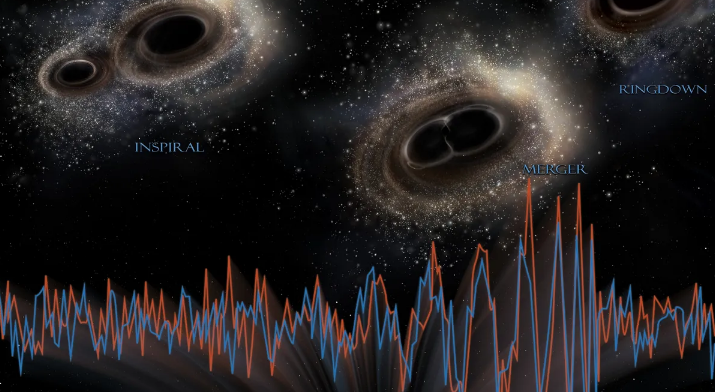Scientists have shown how gravitational waves sound

Gravitational waves are ideal for converting into sound. A small chirping, at the moment of collision, it has already turned into quiet sounds. My ringtone, on the rare occasion that my phone can hear a sound, is one of those calls. Now the Audio Universe team has taken gravitational wave data to a whole new level.
The visuals and sound are brilliant in the 3D video, where the sounds of gravitational waves hit you from the direction of the sky from which they are estimated to have come. As you move around with a mouse, phone, or VR headset, you can be enveloped in tiny vibrations in space-time. “Using our best estimate of where these signals are coming from across the sky, we can use spatial sound to place them around the listener, and we light up the sky at those locations. Using our STRAUSS code to generate the audio, we sped up the timing and signals a bit to place them in an audible range and fit them all into the video. Together, you can experience the sky in gravitational waves,” Dr James Trayford from the University of Portsmouth told IFLScience. Like other ultrasound projects, it enables blind and visually impaired people to participate in astronomy, complementing other approaches such as Tactile Universe. But there are more motivations than just that.
"There are three reasons why we want to do this. It helps researchers explore complex multidimensional datasets. It can be used to create engaging and engaging educational resources. And it can make astronomy more accessible, which is obviously very important," Rose Shepherd of the University of Newcastle told IFLScience. "Making things accessible actually makes them better for everyone." A particularly interesting aspect of sounding for research is the possibility of listening to the radiation lines of celestial objects. Peaks in the light spectrum of a particular body spread as the object moves, and ultrasound can transform something so visually subtle into something blatantly obvious to the ear. But it is useful not only in astronomy. The team explored how different datasets could be enhanced by adding an audio element. One interesting example is the Warming Stripes. It's a minimalistic graphic that uses a series of color bars – from blue to red – to show temperature anomalies over the years. The left side represents decades ago, and as we approach the right side, the bars get redder. Great for visualizing the unfolding climate crisis, and now the audio adds a little more to it.
“Using sounds, it can add an emotional interpretation to your data. You can use that to convey certain feelings to the data,” Shepherd explained. "With [the Warming Stripes soundtrack], we weren't trying to make people feel stressed, but it was interesting to see people's reactions compared to just watching the video." Audio Universe is developing a Sonification Toolkit that can be used by many to create custom resources.